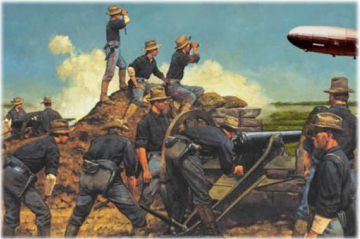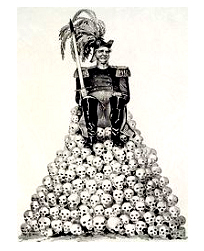Unproduced Television
Like many Television writers Beau L'Amour built up a large file of unproduced projects. These ranged from "Sanctuary" in the 1980s, a TV series proposal about an upper class Central American army officer on the run as an illegal alien in the United States while trying to discover the identity of the operatives who set him up as the perpetrator of a Mai Lai style massacre in his home country, to "The Dark Shore," a Science Fiction or Fantasy series dealing with the crew of a mysterious freighter on the eve of WWII.
He also struggled to produce a number of Louis L'Amour properties but was only partly successful. Disappointed in either the outcome or the process, he ultimately decided it was better to focus on publishing projects. Along the way, however, he found that he had created a number of interesting adaptations of his father's work that never even made it onto the desk of an agent or a studio executive. In a few of these cases what is reproduced on these pages is just the "concept" page of an extensive bible, a bible that contains the general arc of the plot, character descriptions, and treatments for episodes. We have limited what can be read because TV companies are often very sensitive to whether or not anyone has seen the material ... they all like to be the first ... and we do hope to sell it someday!
Haunted Mesa
Around 2008 a producer friend of Beau's challenged him to write a film script to Haunted Mesa, a book the man considered nearly impossible to adapt. Beau took on the challenge but then cheated and instead created a TV Series Bible; the longer and more open ended format helped solve many of the issues that both he and his father had encountered with this story.
Besides the concept page seen below, this bible includes: a character breakdown, episode treatments, a complete description of the arc of season one, and a script for the first episode.
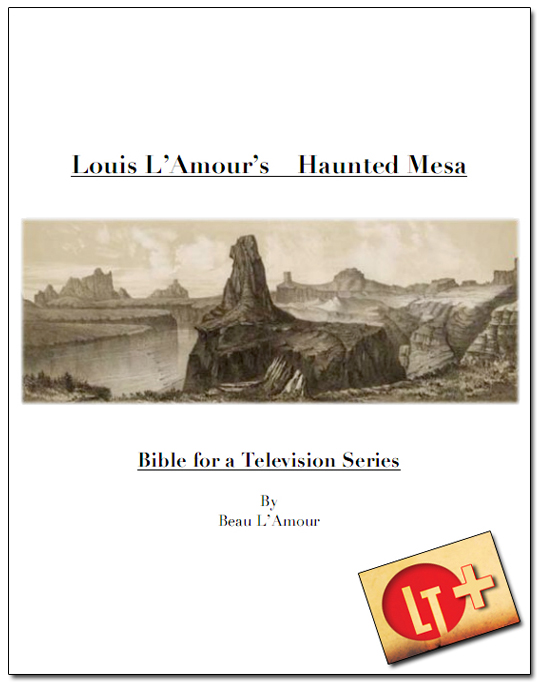
Haunted Mesa
Concept
While developing an advanced surveillance device, wealthy inventor Eric Hokart stumbles onto a way to detect areas of congruence, thin spots, that sometimes connect our world to another. This Alternate Earth is similar to ours geographically but, for the last several thousand years, it has experienced a vastly different history.
Hoping to explore the far side of this strange new border, Eric reaches out to Mike Raglan. Once a Captain in the Special Forces, Mike led the team in Afghanistan assigned to test Eric's equipment in combat. But when Mike cannot be found, Eric's curiosity gets the better of him . . . and he steps through the portal into the unknown.
With The Haunted Mesa Louis L'Amour created the basis for a unique "alternate world" Science Fiction series. The main setting is the modern American southwest, a land of red rock canyons, mesas, parched Indian reservations, and sun blasted one-street towns. In our world it is a haunted land where the ruins of ancient peoples hide in huge wind hollowed caves, and mysteries lie coiled in every shadow. In the Other World the remnants of an ice age still hold sway. There are no glaciers so far south, but the land is cold, dry, and distinctly inhospitable. The level of human population is considerably less and ancient mega fauna, like cave bears, giant sloths, and saber-tooth cats can still be found. There is only one civilization north of the equator, the seven cities of Xibalba, (She-bal-ba). A modern culture in its own way, it has a level of science, art, and architecture equivalent to, but very different from, our own. It is also a stifling theocracy where suspicion and darkness rule every relationship and human sacrifice is common.
A relatively stable portal in Mexico has allowed communication between worlds to go on for a very long time. Conditions and culture in Xibalba have influenced the Olmec, Mayan and Aztec peoples on our side . . . and visa versa. Today, Xibalban agents use the portal to traffic the most exotic drugs on the market as they maneuver for wealth and power south of the U.S. border. Their ultimate goal, a political foothold in our world.
Eric Hokart's discovery of a nearly forgotten portal within in the United States is an opportunity and a threat to those tasked with Xibalban security and operations. Once they are aware of its existence they will go to any lengths to control it.
Arriving to find Eric missing and a community suspicious of outsiders, Mike Raglan has the nearly impossible job of discovering what has happened. But with mysterious prowlers scouting Eric's high tech home in the remote Utah canyon country; strange creatures reported on the nearby Navajo reservation; and a fantastically violent drug cartel called The Army of Cibola moving north from Mexico, there is plenty of evidence that something quite unusual is going on.
Meanwhile, Eric is lost and in danger somewhere in the silent canyons of another world . . . and Mike has to follow the few clues Eric has left before time runs out.
WGA Registration
#1589074
The Walking Drum
Instead of creating a whole bible for a potential mini series, in this case Beau attempted to boil the differences between a film adaptation and the novel down to the fewest words possible. The main goals of this adaptation were to:
- Create and maintain one significant "bad guy" who is consistent throughout the entire story,
- Keep the character of Mat's father present even though he is not on screen by having Mat learn more and more about the mysterious Jean Kerbouchard as he goes about looking for him,
- Continue to use some of the wonderful characters we are introduced to rather than leaving them behind, and
- Keep the action contained in Europe and the Near East to make the locations affordable. There are a few other details, mostly introducing aspects of Mat's life that are explored in the beginning only to bear fruit in the end, but the idea was to make it short and sweet.

The Walking Drum - An Adaptation
This twelfth century adventure story was a New York Times Hardcover Bestseller for over four months when first released. Edgy, picaresque and youthful, it has distinguished itself as a classic in the genre and, in almost thirty years, has never been out of print. Though Louis L'Amour's fame is connected to a genre at the opposite end of the fictional spectrum, The Walking Drum remains the individual L'Amour title most continually referenced in fan mail and on discussion forums.
*****
It is 1179 AD. A band of pirates raids a secluded compound on the Breton coast. The lady of the house, a mysterious beauty brought there by her husband from eastern lands, is raped and murdered and her servants and guards killed. Only her teen-age son survives, taken as a slave to man an oar on a corsair galley.
Mathurin Kerbouchard has no choice but to accept his fate. However, that does not mean he will do so willingly. The pirates are lead by Hugh de Tournemine, once a deputy to Mat's father, Jean Kerbouchard, a legendary corsair. Tournemine has staged a mutiny, captured Jean's ships and turned most of Jean's loyal crew into slaves at the oars ... Jean himself, however, has disappeared or suffered some unknown fate at the hands of Tornemine. Mat vows to the men around him, men who served with his father for many years, that he will both discover his father's fate and have his vengeance.
It will be a long time coming. After several coastal raids and a storm, Mat's ship is separated from the fleet. With a facility for navigation learned as a child Mat is able to turn the tables on his captors, staging a mutiny and freeing a lovely Moorish hostage, Aziza. Arriving in Cordoba he manages, with the help of the cunning beggar, Khatib, to sell both the cargo and the ship for a tidy profit ... with it's pirate crew in the place of one-time slaves. Some of the cargo is purchased by a Merchant Caravan which is being formed, the White Company of Traders, and Khatib goes with them as they set off across Europe.
Kerbouchard searches for information about his father and learns a bit here and there. Jean was liked and hated, a man with a reputation and a temper. The differing stories and clues to his whereabouts are a challenge for his son to piece together. In Cordoba, Mat finds himself both an income and an education working in the society of translators. Making the most of the opportunity he studies geography, alchemy, medicine and the marshal arts of sword and westling. Islam is a world spanning culture at this time in history, on the cutting edge of science and social organization and Kerbouchard has landed in its most progressive city.
Mathurin helps out and is aided in return by Safia, a beautiful woman in her late thirties who is mysteriously involved with the struggle for power in Moslem Spain. It is a struggle that Mat finds himself in the center of whether he likes it or not as Aziza reappears and a romance blooms between the two of them. Her impending betrothal makes her a pawn in Safia's conflict and Kerbouchard finds that romantic jealousy and political intrigue can be a lethal combination. Mat is imprisoned and, effecting an ingenious escape, must flee with Safia as the plotters are rounded up and executed.
Safia is a Persian spy and the two of them, bound by platonic respect and ill fortune, take to the countryside where they eventually catch up with the White Company and join them on their route to Constantinople. She and Mat become merchants and the carnival-like caravan trades and battles it's way east.
Eventually, Safia will take her leave to return to Persia but has used her clandestine connections to discover a rumor that Hugh de Tournemine continues to be active as a pirate and that Mat's father may still be alive somewhere in the Holy Land. Khatib takes a job with the performers and acrobats and Mat puts his alchemical training to use as the physician to the caravan. They journey to Paris and on to Kiev. On route, Mat meets and romances Suzanne de Malcrais who is traveling to Lebanon to reclaim her dead husband's estate, a powerful castle guarding the Northern border of the Christian held lands. To do so she will have to raise an army and depose her traitorous brother-in-law.
In Kiev the untrustworthy Prince Yuri seeks to impound the caravan's goods and when he cannot, he makes a deal with the Mongol-like Petchenegs to destroy and plunder the White Company on its way to Constantinople. Though the caravan is easily the match for many local armies in Europe the Petchenegs are numerous and terrifying fighters. Hunted down and slaughtered on the shores of the Black Sea only a few of the White Company escape in boats or by hiding among the dead. Months later, Mathurin, a shadow of is former self, makes his way into Constantinople to regain his health and his mission.
Mat undertakes a duel of storytellers in the marketplace and thus secures a street corner from which he can earn himself a small bit of change. Safia's connections lead him to discover that his father may be still alive, a slave in a mysterious fortress Masayf deep in the Syrian mountains. Kerbouchard struggles to learn more about the mystery that is his father and to prepare himself physically and financially for the struggle ahead. Reconnecting with Suzanne, the two aid one and other in preparing for their upcoming ordeals. Using the guise of ibn-Ibrahim, a traveling alchemist and scholar, Mat succeeds in securing an invitation from the master of Masyaf ... leader of the secretive cult of The Assassins.
Even as he is preparing to leave, Mathurin meets a woman who makes him forget all those who came before: she is Sundari, a beautiful Rajput betrothed to a cousin of the Caliph. The connection between the two of them is something Mat has never experienced before ... not simply attraction but love. So powerful and obvious is the attraction that her bodyguard, tasked with transporting her to Egypt and her future husband, tells Kerbouchard he must come after her ... even if it means that he and Mathurin must cross swords!
But first there is his father to consider. Reunited with Khatib, Mat sets off into the cauldron of the Middle East, a place where Crusaders, Arabs, local Christians, Jews, Seljuk Turks, and the Ismalis all vie for territory and power. Once he arrives at the fortress, Mat must convince its master of his alchemist credentials, find his father and plot their escape. But there is another obstacle to be overcome, the Ismali lords have allied themselves with a force that gives them a way to terrorize the seas even as they strike fear into the lords of the lands ... and that force is the remnants of Jean Kerbouchard's pirate fleet now lead by Hugh de Tournemine, the man who murdered Mathurin's mother.
Louis' research took him to the RUE de KERBOURCHARD
The Walking Drum was designed to be followed by two sequels. A Woman Worth Having and May There Be a Road. These sequels were never written but there is fragmentary evidence of the story they were to contain. Unlike many stories in the 'Historical Novel' genre The Walking Drum has a sense of being youthful and raw, energetic and irreverent ... and the possibilities to expand these qualities into a cinematic adaptation are endless.
The Californios
Another difficult Film adaptation made easier by the more generous time constraints found in TV, Beau expanded The Californios to take in the years before, during, and after, the Mexican War: an amazingly dynamic time in our country's story that has been nearly lost to history.
What is posted here is just the cover or "concept" page of an extensive bible, a bible that contained the general arc of the plot, character descriptions, and treatments for episodes. There are limits to what can be released here for you to read because TV companies are often very sensitive to whether or not anyone has seen the material ... they all like to be the first ... and I do hope to sell it someday!
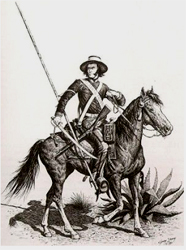
Concept
California. Tall mountains and sun swept beaches. A central valley ripe for farming. Dense forests of giant trees. There are growing cities and trade with the Far East, a culture of leisure and refinement, a haven for alternative spirituality. It's a place where fortunes can be won or lost. Style and prestige are everything, who you know is who you are and corruption lurks in the corridors of power.
There is tension on the border. Illegal aliens are challenging the economy, betraying the old values and altering the sense of community. Some are hard working and honorable, trying to make a future for themselves that would have been impossible in their native land. Others are drunken and bigoted troublemakers, criminals, ganging together and on the verge of rebellion.
These foreigners are from the United States . . . and the Mexicans of Alta California want them out.
The year is 1845 and a storm is coming, a war that will tear California apart. The United States of America against the Estados Unidos Mexicanos. Religion against religion, race against race, generation against generation, lover against lover, friend against friend . . . it's an entirely different kind of Civil War.
Louis L'Amour's The Californios follows the fortunes of the Mulkerins, an Irish- Mexican family who must survive the confusion created by the death of their mysterious patriarch, Colonel James Mulkerin, and the oncoming chaos that existed in California before, during and after the Mexican War of 1846-1848.
Presented as a Series or Mini Series, The Californios extends the time frame of Louis L'Amour's novel. Our adaptation would chronicle the end of a timeless and elegant way of life and the creation of a new state in a growing country. Steering a politically even handed course, we would explore a story where cultures dramatically collide but where people of diverse backgrounds and visions for the future must learn to live and work together.
Searching for love, opportunity, revenge, and redemption, the characters of The Californios lead us on a journey both of idealistic hope and Shakespearian tragedy . . . a journey through the juxtapositions that define the essential nature of the Golden State, the tragic search for an Eden on the Pacific and the need for change that is both its constant resurrection . . . and downfall.
WGA Registration
#1589075
Son of a Wanted Man
This script was one of the first that Beau ever wrote. He and co-writer Charles Van Eman produced the first drafts before Louis L'Amour's death and, eventually, it was produced as a special three hour Audio Drama presentation by Random House. The series concept is basically a sequel; a look at a family that is trying to survive with a cantankerous, semi retired, old outlaw as its somewhat dysfunctional patriarch.
Beyond the script, which can be presented in the form of a movie of the week style pilot or two individual episodes, there exists a full television series bible containing: character breakdowns, season one arc, and descriptions of individual episodes.
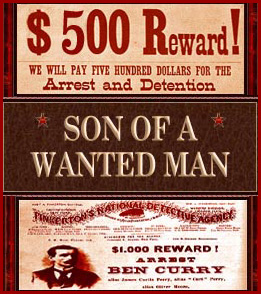
The Concept
Throughout history new generations have struggled to establish their position in relationship the old. This is true of children and their parents, it is true in the world of business and industry ... it is even true in the war between lawlessness and crime. Set in the rapidly industrializing west at "The Turn of the Century" Louis L'Amour's Son of a Wanted Man takes a unique look at the tension between one generation at the end of it's era and another at the beginning of our own.
Though the last decade of the 19th century marked the closing of the frontier, the wild ways of the Old West were still present in outlaws like Butch Cassidy and lawmen like Wyatt Earp. Apaches still raided across the border from Mexico and vast tracts of wilderness were still uninhabited. Yet at the same time there was enormous growth in the western businesses of mining, agriculture, ranching and logging.
Civilization in all its positive and negative aspects was found in the west. Boise, Idaho was plumbed for geothermal heat, Oregon City and Telluride, Colorado began to use electric power. The world heavyweight boxing championship was fought in Goldfield, Nevada and so was a bloody labor war between miners and their bosses. In fact violent strikes, complete with bombings and shootings were common in towns like Leadville, Coeur d'Alene and Cripple Creek.
You could also place a call on any of a hundred thousand telephones, travel a mile a minute on streamlined railroad carriages, drive a motor car, collate data on a punch card tabulator or even go to the movies. It was the era of H.G. Wells, Jack London and Dashiell Hammett's brutal "Continental Op;" the Wounded Knee massacre, the Oklahoma land rush and the great Chicago exposition; X-Rays, Ragtime and "Remember the Maine".
In the rapidly growing mining town of Brandt's Crossing, California, ex-outlaw Ben Curry and his adopted son Mike Santos struggle with their differences over Ben's dark and violent past. They must try to keep Ben's identity a secret from Mike's new employer, a railroad that was once the victim of the old man's thievery. And they must win the trust of the young ladies who form the rest of their unconventional family, Drucilla and Juliana, Ben's attractive daughters.
But, most challenging, they must find some way of working together to confront a new sort of crime that, because of Ben's forced retirement, has begun to spread to Brandt's Crossing and the surrounding communities. The Blaxland Rushcutters, a violent gang emerging from the waterfronts of Australia, is making a bid to take over San Francisco and the Sacramento delta, organized like the Irish mob in the eastern United States they are a criminal enterprise the likes of which the West has never seen ...
Reilly's Luck
This was a comprehensive set of notes created for a possible mini series adaptation that fell through even before the contracts could be discussed. Beau's notes deconstruct the novel in an attempt to discover the basic components of a film adaptation. What emerges is quite remarkable; the hidden underpinnings of just what gave the work of Louis L'Amour its lasting magic!
Reilly's Luck is one of Louis L'Amour's most complex and personal stories. It contains significant aspects of Louis's own history and is constructed around the contrasts between the two halves of his life and career. Up until WWII Dad lived the life of young and somewhat pretentious poet trying to charm his way into literary society. He was a man much like Will Reilly who put on a good show and, though nearly penniless and with only the vaguest beginnings of a writing career, nearly married a modestly wealthy French Countess. After the war Louis settled in to become more like Val Durrant, a practical laborer laying the ground work for a serious career and finding a woman who could help him succeed in life on his own.
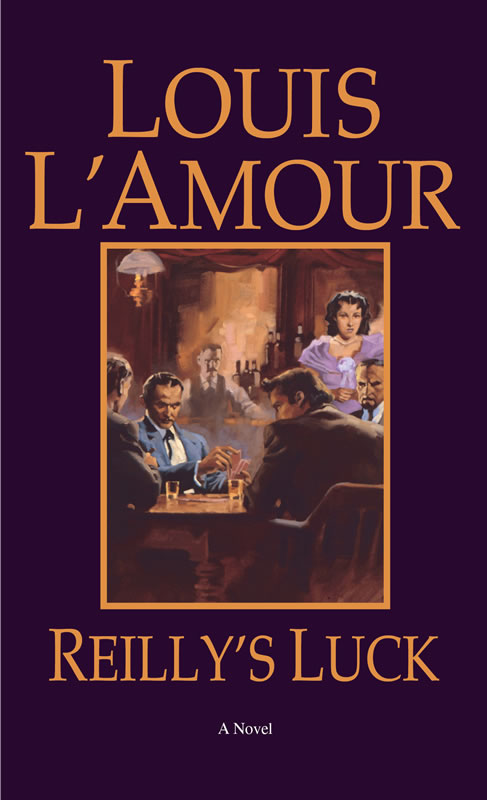
An investigation of the novel for the purposes
of a mini-series adaptation by
Beau L'Amour
The following notes are Beau's ideas and thoughts as they relate to the possible adaptation of Reilly's Luck as a television mini series. Louis's material was often written in a single swift pass, usually within about ninety days. Often it contains a certain emotional truth but relies on the imagination of a reader to fill in the gaps. While this is the high art of prose writing, when trying to convert the material into another medium, it needs to be backed up with additional logic and more fully fleshed characterization. Identifying those truths is always my first consideration when I look at one of his stories. The rest of the job is to make the most of what is implied, to bring what Louis has suggested to greater and fuller life.
The amazing thing about any novel is the amount of unconscious material that is activated in the mind of the reader. Whether any other reader would come up with exactly the sort of ideas that I have set down here is inconsequential ... what is meaningful is that these stories have a life that is additional to the exact words that are set down on the page. The thoughts they inspire, perhaps even below the threshold of awareness, can turn even a run of the mill piece by any writer into a classic. In a way, we readers are co-authors, each of us bringing our own imaginations to the festival that is reading!
Reilly's Luck is essentially a Dickensian rags-to-riches story. To follow that model, the orphan child is adopted by a mentor who teaches him about life. When that mentor dies the young protagonist is forced to survive and apply those lessons completely on his own ... eventually surpassing the mentor and becoming the most well formed character they have the potential to be.
To that end some elements of this novel need to be shifted around. Will Reilly's death should be postponed until around the half way point, Val's mother, Myra Durrant/Cord, needs to be integrated more fully into the entire narrative as the primary villain and she should be connected with Hank Sonnenberg, the more physical threat, from the first.
I've made notes to all this and more at the end of each section. These sections are not necessarily "Acts" or different episodes of a suggested script, I never got that far in my work, they are simply different areas of the story that require separate examination. Enjoy!
Beau L'Amour
Section One
Our story begins in the middle of a cold Montana winter sometime during the early 1870s. A four-year-old boy huddles under the covers of his bed, listening through the thin hotel wall as his mother MYRA CORD fights with her "friend," VAN CLEVERN, about the need to get rid of her son. Van pleads for Myra to reconsider but she snaps back with, "Get rid of him permanently or I'll get rid of you!"
VALENTINE (Val) hears the door close and Van's footsteps come down the hall. A key rattles in the lock and Van enters. As Val has spent his short life being moved from one foster family or caretaker to the next, Van has been a source of kindness for him. Myra, on the other hand, has supported herself through prostitution and other unsavory deeds. Her son, who she had once hoped would allow her to trap a prosperous miner, named Durrant, has become a chain that is tying her down in far too many ways.
Van, though weak to Myra's demands, is unable to do something as terrible as killing a four year old. Instead of leaving him to die in the snow, he takes Val to the one person in town he knows can trust: WILL REILLY. Will is a gambler by profession but respected by many. Coldly handsome, he is both cultured and educated ... though those qualities are more self-taught than the result of his environment. Told that Van just needs a to figure out what to do with the boy, Will allows him to spend the night in his hotel room. When Val and Will watch Myra and Van leave town in the morning, Will realizes that the boy has become his responsibility.
Val has had a difficult life, but he is now in very capable hands. Will starts to pass along telling the boy that he will have to depend on himself and to learn as much and as quickly as possible. Will sees himself in the kid, as he had to look after himself at a very young age as well.
After a few days of babysitting young Val, Will learns that the reverend of the town is planning to take the boy. He doesn't think a gambler is fit to raise a child. Acting quickly, Will prepares to leave. As a snowstorm rolls into town, Will gathers up some last provisions into their wagon and heads out into the night with Val.
Several hours pass, the snow becomes dangerously deep and the temperature plummets. Will reassures Val that there is a cabin not too far down the road and that it is essential to always keep moving. Will explains that the cabin is a hideout for outlaws and there may be people who don't want guests inside. It turns out that inside there are three men: TENSLEEP, an outlaw but a man who likes and respects Will Reilly, HANK SONNENBERG, a heavyset bearded man, irritable and suspicious, and TOM, a tall, lanky criminal, who is known to the Durrants (Val's father's family), yet has a reputation of being mentally unstable. There is a tense moment as Hank and Will face each other over whether they will be allowed to stay, but Tensleep intervenes and vouches for Will.
The next morning, Will expresses his gratitude by leaving some supplies and they head back out onto the road. Will tells Val that with the men at the hideout, Sonnenberg was the meanest and strongest, but Tom was the real danger because of his unpredictable nature. As with all of Will's lessons, Val soaks it in. Val realizes that Will is teaching him the things that he himself values. These things include being a gentleman, being responsible, having courage, and always keeping one's word.
Section One Adaptation Notes:
Establishing a certain knotting of fate that brings the stories of Myra, Sonnenberg, Val, and Will together at many different points will provide a structure that promises the audience a complete development and resolution of each of their stories. As the mother who orders her child to be killed, Myra is the true villain. But unless there is a strong story element connecting she and Val at the end it is hard to bring them believably together at that point. Their paths must be intercut throughout the story so that none can be forgotten.
We could establish Myra's first attempt to better herself as a way to set this up. She sets her sights on Durrant, a prospector who owns a good deal of mining property (it needs to be property because "claims" are hard to legally maintain the rights to). In her mind having his child will lock the two of them together. Once Val is born she should discover that, though the mines are valued highly by Durrant, they do not contain gold ... the only mineral that Myra, as an ignorant young woman, can appreciate. At this point Myra dumps Durrant and takes off. Val is shuffled from one caretaker to another until finally, at the start of our story, some problem sends him back to his real mother.
When she becomes older and wiser, this decision can haunt her. The claims were copper, a commodity that, as the years pass rapidly increases in value. Though marrying Durrant was her first attempt to aggressively better herself, through her ignorance, she has let the opportunity slip away.
At some point before the half way mark in the story, Durrant should die and Val should inherit those claims from Durrant's will. This allows the early part of the story to relate to the ending when Myra tries to reclaim the mines that slipped through her clutches back when she ... and Val ... were young.
Myra's next attempt at feeding her ambitions could be getting involved with Hank Sonnenberg. Sonnenberg is presented later in the novel as a well rounded criminal, not just a violent hold up man. At the time the story begins She could be given a chance to join his gang in a scout or seductress role and must soon head off to make that rendezvous. It is a step up from prostitution.
It might be that Sonnenberg has never been all that venerable to Myra's wiles. Thus she could be all the more driven to try to seduce and control him ... something that she might never quite succeed at. This makes her ready to do what it takes to get "in" with him; like give up the son who's been a problem for her ever since she realized Durrant wasn't rich. A son who would not be welcome as a part of the criminal gang she wants to be a part of.
Sonnenberg, in the scene at the cabin, could be on his way to the same rendezvous as Myra ... somewhere that they will begin whatever arrangement they have worked out. Myra and Sonnenberg should be in their 20s at this point in the story, a very typical age for men and women active in the history of the west.
Van Clevern is a very interesting character, sort of like the soul or the morality that Myra give up somewhere along the line. I have always assumed he was gay ... maybe the only gay character Louis ever wrote about.
Will might win big the first night after he takes on Val. It could seem like a sign of some sort and it inspires Will to look at Val as something like a good luck charm.
To read MORE of this breakdown, please visit Louis L'Amour's Lost Treasures
where the full 10 sections are available.
For more information about this or any of the other titles mentioned here,
please contact Beau L'Amour directly.
